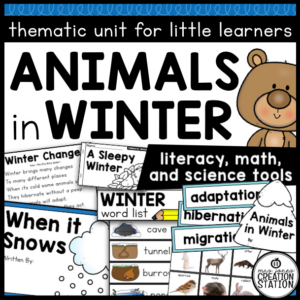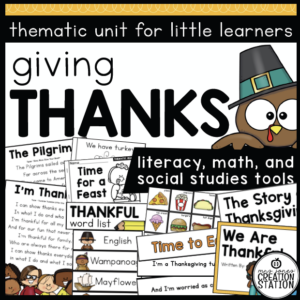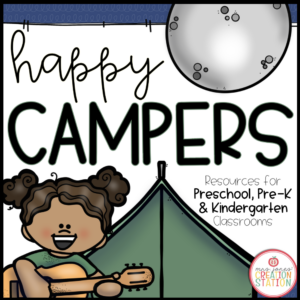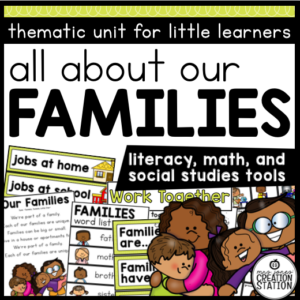Menu
This resource includes thematic lessons, activities, poems, songs, and centers for your little learners. Adapt these resources to meet the specific needs of your learners in whole group, small group, and independent instruction.
Buy the BUNDLE and SAVE! You can purchase this resource in the Thematic Activities for Little Learners Bundle!
Week 20 Plans
This is a template for lesson plans during community helpers week of school. For best results, pick and choose what ideas and resources work for your learners. Furthermore, you may adapt the resources to best meet your students’ needs.
Community – Whole Group
These resources can be used during whole group instruction for a community helpers theme. During whole group instruction, you may use the poem, word cards, tracing page, and table sign-in sheets.
Community Helpers Interactive Poem
During this thematic lesson, students may use an interactive poem in whole group or a literacy center. For instance, have the learners change the helpers and read the poem together.
Community Sensory Charts
During this activity, students may explore their community with the five senses. For example, complete the charts together and then have learners draw and write about their community using their senses on the interactive page.
In Our Town Predictable Chart Class Book
Use this resource to create a class book from the predictable chart created during the week.
Community Thematic Plans
During this thematic unit, these plans may be used as a guide for engaging community helper read alouds and activities in the classroom.
Our Community
During this thematic lesson, read This is My Town. Then, have learners work together to create a community map using butcher paper and the building images included.
Our Helpers
During this thematic lesson, complete the Community Helpers puzzles together by matching each helper to their workplace. Then, have learners color the helpers and glue the buildings and helpers onto the map. Finally, learners may also add details to the map.
Helper Hands
During this thematic lesson read Whose Hands Are These? Then, have learners chose a helper from the “helping hand” visuals. In addition, you may take a trip to the school library or provide books for learners to use for research. Have learners use the books provided to complete the community helper research page by drawing or writing details about their community helper. Two days are allotted for this activity.
Visitors
In place of the time schedule for the Helping Hands, activity visitors may be scheduled to come to discuss their job with learners.
When I Grow Up
During this thematic lesson, read When I Grow Up. Then, have learners create a helper using the face template and by using materials provided to create hats, clothing or other details. Finally, learners may also complete the writing page included.
Literacy Center | Ending Sound
During this learning center, learners match the picture to its correct ending sounds on the computer puzzles. Then learners may record the answers on the page provided.
Literacy Center | Letter Match
During this learning center, learners match the uppercase and lowercase cards on a pocket chart. Then learners may record the answers on the page provided.
Literacy Center | Sight Word Write the Room
During this learning center, learners find the sight words around the room and write the word on the printable provided.
Math Center | Counting
During this learning center, learners count the correct number of hammers for each construction worker. Then learners may record the answers on the page provided.
Math Center | Create the Pattern
During this learning center, learners use pattern cards and visuals to create a pattern. Then learners may record the answers on the page provided.
Math Center | Shape Sort
During this learning center, learners sort the shapes on a pocket chart. Then learners may record the answers on the page provided.
NGSSK-ESS3-3
Communicate solutions that will reduce the impact of humans on the land, water, air, and/or other living things in the local environment. Examples of human impact on the land could include cutting trees to produce paper and using resources to produce bottles. Examples of solutions could include reusing paper and recycling cans and bottles.
CCSSMP8
Look for and express regularity in repeated reasoning. Mathematically proficient students notice if calculations are repeated, and look both for general methods and for shortcuts. Upper elementary students might notice when dividing 25 by 11 that they are repeating the same calculations over and over again and conclude they have a repeating decimal. By paying attention to the calculation of slope as they repeatedly check whether points are on the line through (1, 2) with slope 3, middle school students might abstract the equation (𝑦 – 2)/(𝑥 – 1) = 3. Noticing the regularity in the way terms cancel when expanding (𝑥 – 1)(𝑥 + 1), (𝑥 – 1)(𝑥² + 𝑥 + 1), and (𝑥 – 1)(𝑥³ + 𝑥² + 𝑥 + 1) might lead them to the general formula for the sum of a geometric series. As they work to solve a problem, mathematically proficient students maintain oversight of the process while attending to the details. They continually evaluate the reasonableness of their intermediate results.
CCSSRF.K.3c
Read common high-frequency words by sight (e.g., the, of, to, you, she, my, is, are, do, does).
CCSSRF.K.2
Demonstrate understanding of spoken words, syllables, and sounds (phonemes).
CCSSRF.K.1d
Recognize and name all upper- and lowercase letters of the alphabet.
CCSSK.G.A.2
Correctly name shapes regardless of their orientations or overall size.
CCSSK.CC.B.4
Understand the relationship between numbers and quantities; connect counting to cardinality.
TEKSLA.K.2.B.iv
Developing and sustaining foundational language skills: listening, speaking, reading, writing, and thinking–beginning reading and writing. The student develops word structure knowledge through phonological awareness, print concepts, phonics, and morphology to communicate, decode, and spell. The student is expected to: demonstrate and apply phonetic knowledge by: identifying and reading at least 25 high-frequency words from a research-based list;
TEKSLA.K.2.B.i
Developing and sustaining foundational language skills: listening, speaking, reading, writing, and thinking–beginning reading and writing. The student develops word structure knowledge through phonological awareness, print concepts, phonics, and morphology to communicate, decode, and spell. The student is expected to: demonstrate and apply phonetic knowledge by: identifying and matching the common sounds that letters represent;
TEKSLA.K.2.D.v
Developing and sustaining foundational language skills: listening, speaking, reading, writing, and thinking–beginning reading and writing. The student develops word structure knowledge through phonological awareness, print concepts, phonics, and morphology to communicate, decode, and spell. The student is expected to: demonstrate print awareness by: identifying all uppercase and lowercase letters; and
TEKSMA.K.6.A
Geometry and measurement. The student applies mathematical process standards to analyze attributes of two-dimensional shapes and three-dimensional solids to develop generalizations about their properties. The student is expected to: identify two-dimensional shapes, including circles, triangles, rectangles, and squares as special rectangles;
TEKSMA.K.2.C
Number and operations. The student applies mathematical process standards to understand how to represent and compare whole numbers, the relative position and magnitude of whole numbers, and relationships within the numeration system. The student is expected to: count a set of objects up to at least 20 and demonstrate that the last number said tells the number of objects in the set regardless of their arrangement or order;
TEKSMA.K.1.F
Mathematical process standards. The student uses mathematical processes to acquire and demonstrate mathematical understanding. The student is expected to: analyze mathematical relationships to connect and communicate mathematical ideas; and
How can I see what is new in the MJCS store?
Be the first to know about new discounts, freebies, and new products. You can also subscribe to our newsletter to receive access to resources only available to MJCS subscribers, as well as, special offers and ideas!
How can I get credit for my TpT purchases?
Go to your account button at the top of the page. Under the “Buy” section, click “My Purchases “. Beside each purchase you’ll see a Provide Feedback button. Simply click the button and you will be taken to a page where you can give a quick rating and leave a comment for the product. Each time you give feedback, TpT gives you feedback credits that you use to lower the cost of your future purchases. Please leave detailed feedback for each resource, so we are able to create better resources for teachers and students.
How can I find a certain activity in a large PDF file?
If the resource you purchase has a variety of activities compiled into one PDF find the table of contents and click on the activity title. This should take you to that specific activity in the resource.
What can I do if I have a question about a resource?
If you have any questions regarded a resource before purchasing please email me at mrsjonescreationstation[at]gmail.com. Once you have purchased the resource you may use the “Product Q and A” tab on the product page to ask a question, as well.
How do I know if a resource has been updated?
Go to your account button at the top of the page. Under the “Buy” section, click “My Purchases “. Choose to “sort by: recently updated” to see what resources have been updated since you downloaded them last. You can download any updates from there. If a file has been updated, you will see a notification under the resource that says “Newly Updated – Download for Free!”
This item is a paid product created by Mrs. Jones’ Creation Station, Inc. Copying any part of this product, redistributing, selling or placing it on the internet in any form is strictly forbidden and is a violation of the Digital Millennium Copyright Act (DMCA). Thank you for respecting our work!
YES, YOU CAN…
NO, YOU CAN’T…
Click here for a detailed post with step-by-step directions.
You will need to download fonts specified in the resource and install it on your computer before downloading the editable file.
Install the most recent version of Adobe Reader onto your computer. If you have any problems editing, viewing or printing a file make sure your Adobe Reader is updated.
Now you can download the file to your computer. Once the file has downloaded open in Adobe Reader. You should be able to view the editable fields and the text should match the product description. If you have any problems editing the file, make sure you have followed the directions above and then contact me at mrsjonescreationstation[at]gmail.com




